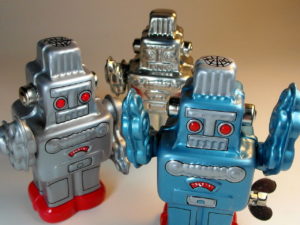 We need to say it clear: in the post-Web 2.0 era (if you prefer, the industrial revolution 4.0) influencer marketing will likely be taken over by bots. Bold statement, right? Let’s have a look back in the past then…
We need to say it clear: in the post-Web 2.0 era (if you prefer, the industrial revolution 4.0) influencer marketing will likely be taken over by bots. Bold statement, right? Let’s have a look back in the past then…
The testimonials era
When the Internet was not even existing, marketing a service or a product was mainly done by direct advertising (at that time, printed newspapers, radio, Tv, outdoor). Some nice and more sophisticated techniques were used few years later, and the “testimonial era” began. Famous people from sport or Tv advertising a product and inspiring consumers to be like them. PR agencies in the driving seat, deciding who’s who in every single industry.
Late 90’s changed dramatically existing scenario. The first wave of influencers in the Internet era were the bloggers: everyone could become a media on its own, and industries like fashion were disrupted as traditional gatekeepers — usually PR agencies — were bypassed by bloggers.
Owning the media
More and more social networks came in with the Web 2.0 era (think about YouTube or Instagram) and more industries were disrupted: the Kardashians-like or Ferragni-like influencers have been able to create massive audiences — and potentially increase sales or awareness of specific brands — without the need of massive budgets or use of traditional marketing and PR agencies.
On one side brands desperately looking to stay in touch with their customers or prospects, on the other side people able to talk as peers to this audience, creating a Win-Win situation.
With influencer marketing becoming a mass technique, more and more services to add fake followers were born, making the return on investment unclear. If everyone can claim to have 1 million followers, knowing if they’re real or fake makes the difference.
As Jonathan Akwue is perfectly summarizing, there’s a growing problem with influencer marketing today: “ the erosion of trust. As more and more influencers cash in and brands become willing to pay whatever it takes for an endorsement, the perception of the influencer as the boy or girl next door is starting to wear thin and trust is declining fast.”
The rise of the robots
If real influencers have a problem of trust, there’s certain an arising star also in marketing and communication: artificial intelligence (AI). From simple chatbots acting on behalf of a customer agent to much more complex systems running an autonomous driving car, artificial intelligence is becoming a key part of every product or service powered by a software.
2017 has been the year of virtual personal assistants (VPA) boom in the consumer space: Apple’s Siri, Microsoft’s Cortana, Amazon’s Alexa, Google Home Assistant (and yes, Oracle’s Athena… less known being a B2B product not available to consumers). They’re ready to listen, understand and — guess what? — advice. They can understand people and suggest actions. In a simple word, they can influence your choices.
The influencer chatbot
Isn’t the same pattern influencers have been using over the past 5 years? Right, a human being is, at the minute, much smarter than an AI-powered personal assistant. Are we sure in 3 years from now the picture will be the same? Of course not.
“Hey Alexa, please order a package of AAA alkaline batteries”.
Can you see the power of the personal assistant now? Alexa will order alkaline batteries and, unless it will be trained do differently, it will order, or at least propose as first choice, an Amazon Basics product.
“Hey Google, book in italian restaurant nearby”.
Can you see the power of the personal assistant now? Google Assistant will book, unless trained to di differently, a restaurant which probably spent money on Google Ads to be first on the preference list.
Trust
There’s still a gap to fill, before bots can takeover influencers, or better become themselves influencers. That gap is called trust. Would you trust a bot to advise today? Unlikely, with exceptions of certain areas (e.g. if you have an issue with a product, you would probably trust a bot showing the right info on how to fix taken from the owner’s manual).
Not a surprise then if all companies are working to build that trust. Teach (and train) people to talk to VPAs is one example: Amazon is offering lower prices on the same product bought using Alexa compared to the same product bought on the website, a clear effort to instill the habit to use Alexa for shopping.
The VPA can now manage the calendar and book appointments on your behalf, tell you how much traffic there’s on your daily commute to work, search weather forecast and call your family members. You will get trained to trust that little AI powered machine, and by the time you will recognize the VPA as a trusted advisor for your life. Machine learning, deep learning, natural voice recognition will do the rest, bringing to the market humanized VPAs.
The brand challenge
The shortcut between the customer and the virtual personal assistant is incredibly powerful, as brands could be struggling in interacting directly to the customer (which has been the main reason influencer marketing has been successful so far in Web 2.0). The market of attention (aka battle for eyeballs) could be over even before it has started: when you have a smart, always-on, intelligent virtual assistant, will you still look for human suggestions? Probably only in very few moments, while the big part will go to Virtual Assistants. Within 2020, 20% of interactions in customer care will involve a VPA.

Ultimi commenti: